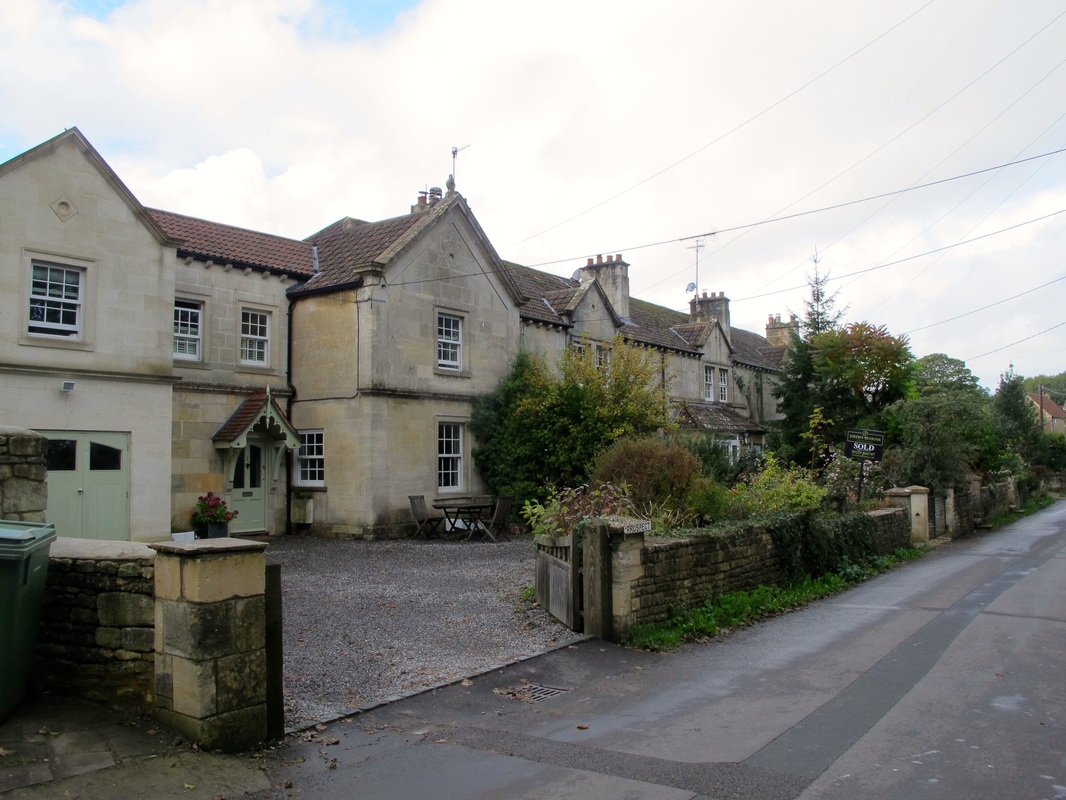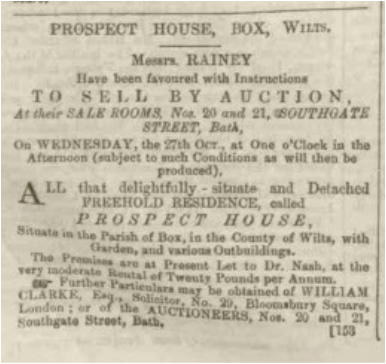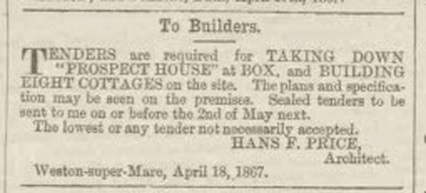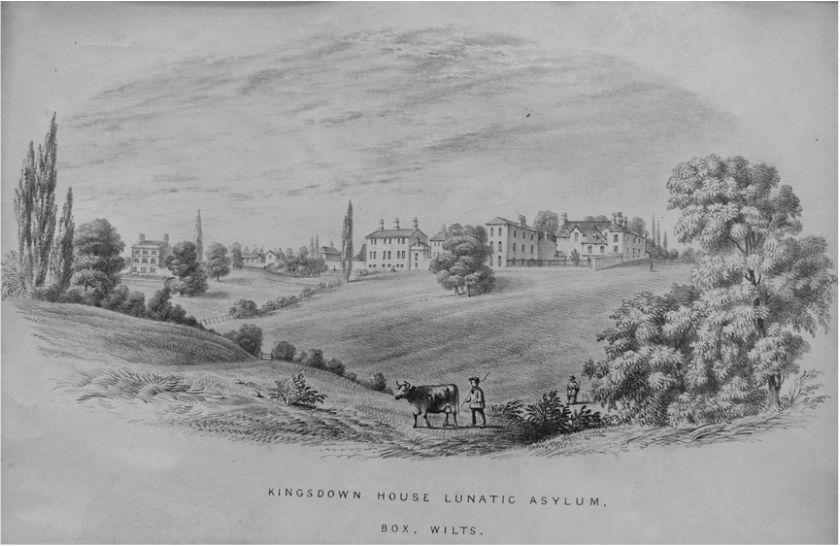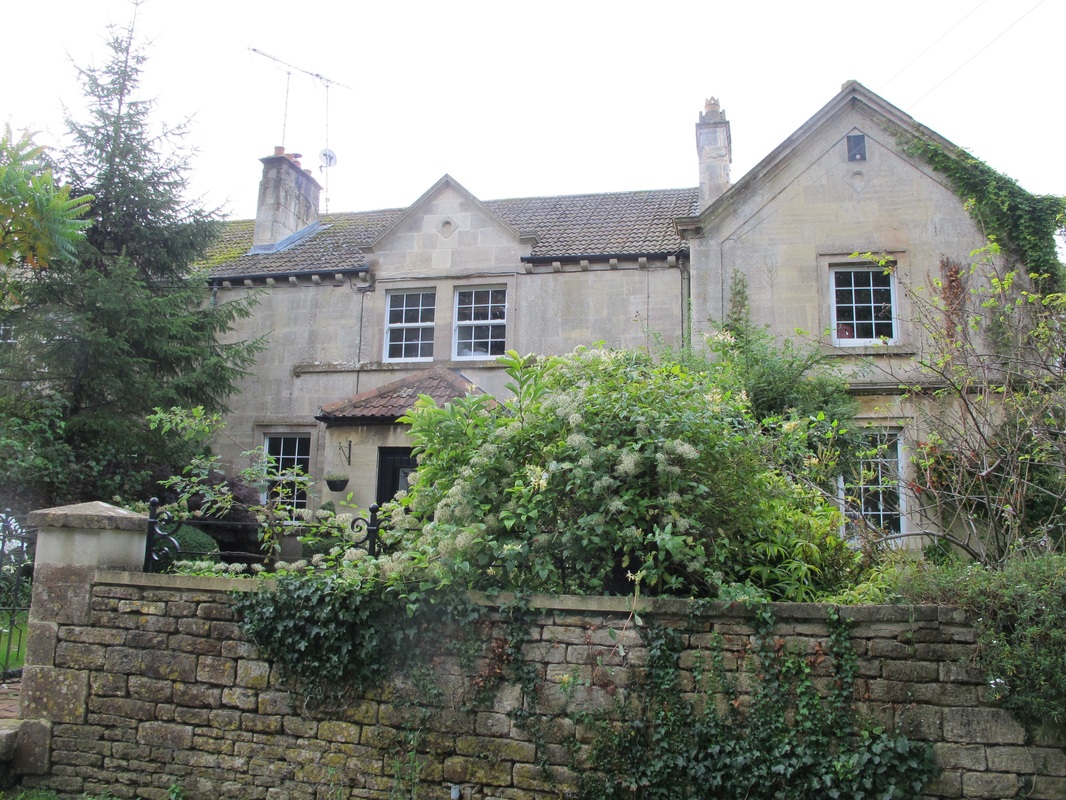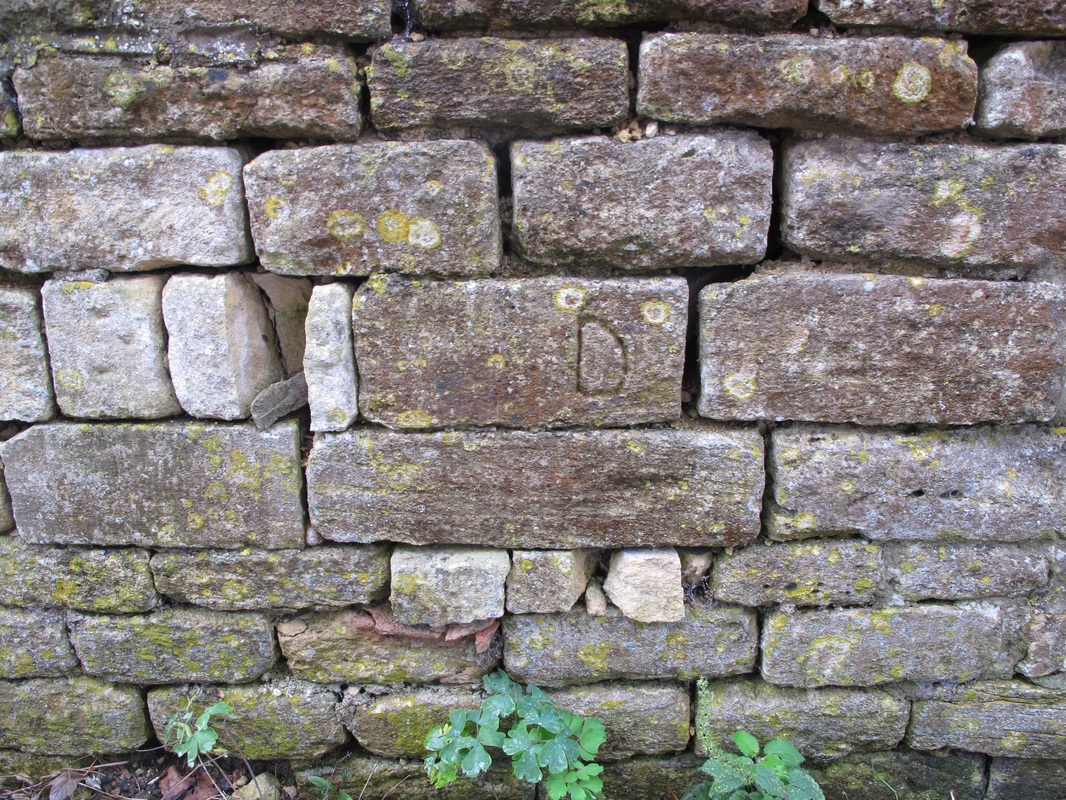|
Prospect Cottages and the
Missing Prospect House Alan Payne October 2015 Prospect House was a grand Georgian mansion somewhere close to the present Prospect Cottages which are reputed to have been built from its stonework. The story of the house is fascinating, as is the history of its owners including Dr Charles Cunningham Langworthy of Kingsdown Asylum who is believed to have built the house in 1810s. Photos courtesy Carol Payne; Right: Modern Prospect Cottages |
Prospect House
The Bath Chronicle of September 1822 records how grand the property was at the time of his son's twenty-first birthday party:
On the coming of age of his only son Dr Langworthy of Prospect House gave a splendid treat for 200 of the tenantry of Box and its vicinity. The morning was ushered in by the discharge of 21 rounds of canon and a band played at intervals. A table was spread upon the lawn, a sheep was roasted whole, a fine ox dressed, and a profusion of plum puddings covered the festive board. In the evening the house was brilliantly illuminated and an immense bonfire was lighted upon Kingsdown. At seven dancing commenced which was kept up to a late hour.
The Bath Chronicle of September 1822 records how grand the property was at the time of his son's twenty-first birthday party:
On the coming of age of his only son Dr Langworthy of Prospect House gave a splendid treat for 200 of the tenantry of Box and its vicinity. The morning was ushered in by the discharge of 21 rounds of canon and a band played at intervals. A table was spread upon the lawn, a sheep was roasted whole, a fine ox dressed, and a profusion of plum puddings covered the festive board. In the evening the house was brilliantly illuminated and an immense bonfire was lighted upon Kingsdown. At seven dancing commenced which was kept up to a late hour.
|
The house was still in existence in 1840 when it was described as Prospect House, Garden, Lawn, Barn, Stable and Conservatory located at reference 625.[1] It seems to be a little set back from the road. Prospect Farm iappears to be reference 622 and Oate Barn reference 621.
Charles Cunningham Langworthy was extremely wealthy. He owned 24 The Royal Circus, Bath and 43 New King Street. He rented the Paddock adjoining Prospect House (reference 624) which he leased direct from the Northey Estate and additional land on the opposite side of the road. Some of his property was held as a sub-tenant of Robert Jefferies, possibly the previous owner of Kingsdown Asylum who had retained an interest. |
Charles Cunningham Langworthy died in 1847, leaving an only son Robert Austin Langworthy, born in 1801. Robert had already taken over Kingsdown Asylum but he died on 23 May 1850 at Prospect House.[2] There appear to have been problems in the family at this stage, which proved complex to resolve. The dispute involved references to the Court of Chancery in London, which was the arbitrator of disputes over land and the administration of the estates of lunatics and the guardianship of infants.
In 1852 the house was advertised as to let comprising three rooms on the ground floor, three on the first floor and four on the second floor, two kitchens, cellar and larder, greenhouse, garden and lawn ... in complete repair.[3]
In 1852 the house was advertised as to let comprising three rooms on the ground floor, three on the first floor and four on the second floor, two kitchens, cellar and larder, greenhouse, garden and lawn ... in complete repair.[3]
|
The property was put up for sale in September 1858 marketed as delightfully situate with Garden and various Outbuildings.
By then the premises had been let to another physician from Kingsdown Asylum, Dr Nash, at the very moderate rental of £20 per annum.[4] It was not very valuable at this low rent and was re-advertised a week later alongside Kingsdown Lunatic Asylum which had been put up for sale by auction: Pursuant to a Decree of the High Court of Chancery in the case of Fuller and Another v Morgan and Others.[5] Left: Extract from Bath Chronicle September 1858 |
Things went from bad to worse. By July 1860 Prospect House was advertised as to let unfurnished comprising dining room, drawing room, breakfast room, 3 best bedrooms, servants (rooms), kitchen and the usual domestic offices.[6]
|
And there was still worse to follow in 1867 when tenders were requested for the demolition of Prospect House and the building of eight cottages on the site, even though the house was less than 50 years old.[7] There has been a long discussion about where Prospect House once stood. If we accept the tender words at their face value then there is an implication that Prospect House stood on the same plot of land as the cottages were built.
|
But this seems unlikely because it would have been impractical to demolish and rebuild on the same land without using the original foundations. We might suppose that the 1840 plan is accurate in showing the house in location reference 625 which is on the south side set up the hill off the road, which would have given a drive entrance suitable for such a grand property. And there still remains a wall behind cottage number 8 which is likely to relate to the original house.
Thanks to our readers we have been shown a marvellous illustration which appears to throw light but may just add to the mystery. The illustration below shows Kingsdown House from the north looking southwards. The isolated building on the left is presumed to be Prospect House because of its grandeur. If so, the house might seem to be located on the opposite side of the road to the modern cottages, approximately where the house Spindlewood now stands. Every time you look the map the mystery of the exact location seems to deepen.
Thanks to our readers we have been shown a marvellous illustration which appears to throw light but may just add to the mystery. The illustration below shows Kingsdown House from the north looking southwards. The isolated building on the left is presumed to be Prospect House because of its grandeur. If so, the house might seem to be located on the opposite side of the road to the modern cottages, approximately where the house Spindlewood now stands. Every time you look the map the mystery of the exact location seems to deepen.
We still can't be certain of the location of Prospect House and readers' thoughts would be appreciated. And we definitely don't know why the property was demolished. It is possible that financial reasons brought its downfall when the estate needed to sell the house to realise the capital value to support the children.
Prospect Cottages, 1867
The cottages were built out of the materials from the demolished Prospect House. It is obvious that the rank of cottages were all built at the same time; they have matching gable ends and all eight were constructed of high-quality dressed ashlar blocks.
The cottages were built as an investment and let out to lower middle class residents who were thriving in late Victorian Box. Many had need of domestic help and there are several references to small family perhaps implying retired villagers trading down.
In March 1878 Bill Hancock advertised for housemaid or general servant.[8]
In 1883 the freehold of the whole rank was advertised for sale as eight substantially-built tenements each having small flower gardens in the front and large rear gardens, each containing four rooms. Seven of the houses were let to respectable tenants at rents amounting to £51 per annum.[9] The properties were sold in 1883 for £800 having a total rental income of £58 and they were sold again in 1899 at an auction held at the Queen's Head when all eight sold as a single lot for £700.[10]
Residents
We get an interesting view of the residents from the census in 1911:
The cottages were built out of the materials from the demolished Prospect House. It is obvious that the rank of cottages were all built at the same time; they have matching gable ends and all eight were constructed of high-quality dressed ashlar blocks.
The cottages were built as an investment and let out to lower middle class residents who were thriving in late Victorian Box. Many had need of domestic help and there are several references to small family perhaps implying retired villagers trading down.
In March 1878 Bill Hancock advertised for housemaid or general servant.[8]
In 1883 the freehold of the whole rank was advertised for sale as eight substantially-built tenements each having small flower gardens in the front and large rear gardens, each containing four rooms. Seven of the houses were let to respectable tenants at rents amounting to £51 per annum.[9] The properties were sold in 1883 for £800 having a total rental income of £58 and they were sold again in 1899 at an auction held at the Queen's Head when all eight sold as a single lot for £700.[10]
Residents
We get an interesting view of the residents from the census in 1911:
|
Number 1 unoccupied
Number 2 Henry Hallett, 68, wheelwright for Bath Stone Firms his wife and their granddaughter. In July 1881 Mrs Hallett needed Single plain cook.[11] Number 3 Mrs Sara Dempster, aged 68, widow who worked as a dressmaker. Sarah had been in the cottage with her three children since 1871. Number 4 James Smith, 75, railway pensioner with his niece, Selina Gardine, and a visitor Fanny Walker. In 1871 Jacob Smith, aged 21, quarryman had lived there and perhaps James was a relative. Number 5 George W Gingell, 47, freestone quarryman, with his wife and 3 children. Number 6 E Whale and his wife Mabel Alice, 25, with their 2 year-old son. |
Number 7 Robert Hall, 59, self-employed Vegetable Grower with his wife and 4 children.
Number 8 Albert Hibberd, 46, carter for the sawmills with his wife and 5 children. Albert was still living there in November 1934 when he was fined 10s for driving a timber wagon on the highway without a rear red light.[12]
Otherwise we only get occasional, tantalising glimpses of the occupiers of the cottages. Many were quarry workers but there were others. In 1891 Henry Kalbitzer lived there. He was originally a German citizen who took British nationality, after serving in the British Army, from whom he received a pension. He later worked as caretaker at Kingsdown Golf Club. In 1871 at Number 7 Job Petty was a gamekeeper and in 1881 Henry Davis was a farm bailiff.
In 1924 Lilian Violet Southard married Joseph William MacDowall.[13] In November 1934 William Dancey was awarded a Royal Humane Society certificate for saving a girl from drowning in the By Brook.[14] In 1937 Doris Elizabeth Alice Cale, elder daughter of JW Cale and former Bath Rotary Carnival Maid, was married to Aubrey Nelson White, well-known footballer now playing for Bath Tramways FC.[15] In 1948 the Hinton family lived at 1 Prospect.[16] In 1949 Francis William John Hazell of 3 Prospect was fined £1 for parking in the wrong place in Bath.[17]
Well-known local residents, George and Rosemary Hill, lived in Orchard Cottage, the property just before Prospect, in the last part of the 1900s. The property was redeveloped in 1947 according to the lintel over the door.
Number 8 Albert Hibberd, 46, carter for the sawmills with his wife and 5 children. Albert was still living there in November 1934 when he was fined 10s for driving a timber wagon on the highway without a rear red light.[12]
Otherwise we only get occasional, tantalising glimpses of the occupiers of the cottages. Many were quarry workers but there were others. In 1891 Henry Kalbitzer lived there. He was originally a German citizen who took British nationality, after serving in the British Army, from whom he received a pension. He later worked as caretaker at Kingsdown Golf Club. In 1871 at Number 7 Job Petty was a gamekeeper and in 1881 Henry Davis was a farm bailiff.
In 1924 Lilian Violet Southard married Joseph William MacDowall.[13] In November 1934 William Dancey was awarded a Royal Humane Society certificate for saving a girl from drowning in the By Brook.[14] In 1937 Doris Elizabeth Alice Cale, elder daughter of JW Cale and former Bath Rotary Carnival Maid, was married to Aubrey Nelson White, well-known footballer now playing for Bath Tramways FC.[15] In 1948 the Hinton family lived at 1 Prospect.[16] In 1949 Francis William John Hazell of 3 Prospect was fined £1 for parking in the wrong place in Bath.[17]
Well-known local residents, George and Rosemary Hill, lived in Orchard Cottage, the property just before Prospect, in the last part of the 1900s. The property was redeveloped in 1947 according to the lintel over the door.
|
More Mysteries
We have already seen that there are several unanswered questions about this area. In fact, there are even more than we have touched on. On the wall of one cottage is a stone marked with D, pictured right. The significance of this is important for the whole of Box village. This is part of a boundary marker showing the area which paid its tithes to the ecclesiastical parish of Ditteridge and that of Box. The B for Box has been lost in the picture. Photo courtesy Carol Payne |
References
[1] Tithe Apportionment record, Wiltshire History Centre
[2] The Bath Chronicle, 30 May 1850
[3] The Bath Chronicle, 24 June 1852
[4] The Bath Chronicle , 30 September 1858
[5] The Bath Chronicle , 7 October 1858
[6] The Bath Chronicle, 19 July 1860
[7] The Bath Chronicle, 18 April 1867
[8] The Bath Chronicle, 14 March 1878
[9] The Bath Chronicle, 3 May 1883
[10] The Bath Chronicle, 24 May 1883 and 9 February 1899
[11] The Bath Chronicle, 14 July 1881
[12] The Bath Chronicle, 17 November 1904
[13] The Bath Chronicle, 2 February 1924
[14] Bath Weekly Chronicle and Herald, 17 November 1934
[15] Bath Weekly Chronicle and Herald, 2 January 1937
[16] Bath Weekly Chronicle and Herald, 6 March 1948
[17] Bath Weekly Chronicle and Herald, 4 June 1949
[1] Tithe Apportionment record, Wiltshire History Centre
[2] The Bath Chronicle, 30 May 1850
[3] The Bath Chronicle, 24 June 1852
[4] The Bath Chronicle , 30 September 1858
[5] The Bath Chronicle , 7 October 1858
[6] The Bath Chronicle, 19 July 1860
[7] The Bath Chronicle, 18 April 1867
[8] The Bath Chronicle, 14 March 1878
[9] The Bath Chronicle, 3 May 1883
[10] The Bath Chronicle, 24 May 1883 and 9 February 1899
[11] The Bath Chronicle, 14 July 1881
[12] The Bath Chronicle, 17 November 1904
[13] The Bath Chronicle, 2 February 1924
[14] Bath Weekly Chronicle and Herald, 17 November 1934
[15] Bath Weekly Chronicle and Herald, 2 January 1937
[16] Bath Weekly Chronicle and Herald, 6 March 1948
[17] Bath Weekly Chronicle and Herald, 4 June 1949
